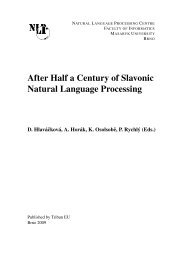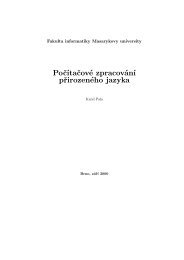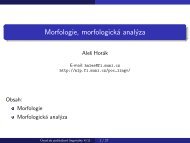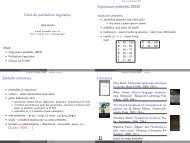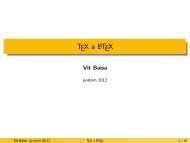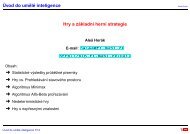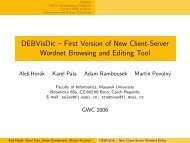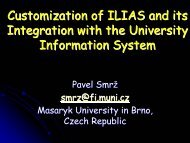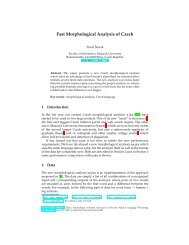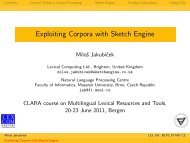GATE: A Unicode-based Infrastructure for Multilingual Information ...
GATE: A Unicode-based Infrastructure for Multilingual Information ...
GATE: A Unicode-based Infrastructure for Multilingual Information ...
Create successful ePaper yourself
Turn your PDF publications into a flip-book with our unique Google optimized e-Paper software.
multiple languages or scripts are grouped together<br />
in several locations, and characters with common<br />
characteristics are grouped together contiguously<br />
(<strong>for</strong> example, right-to-left scripts are grouped together).<br />
Character code allocation is there<strong>for</strong>e<br />
not correlated with language-dependent collation.<br />
In order to enable the tokeniser to handle<br />
other <strong>Unicode</strong> characters, we had to find<br />
the relevant character types and their symbolic<br />
equivalents (e.g. type 5 has the symbolic<br />
equivalent “OTHER LETTER”; type 8<br />
characters are usually at the beginning or end<br />
of a word and have the symbolic equivalent<br />
“COMBINING SPACING MARK” or “NON-<br />
SPACING MARK”). Rules covering these types<br />
were added to the tokeniser in order to discover<br />
the tokens correctly in a variety of other languages.<br />
Even more importantly, having discovered<br />
the technique <strong>for</strong> extending the tokeniser in<br />
this way, it will be easy to add any further new<br />
types as necessary, depending on the language<br />
(since we have not covered all possibilities).<br />
4.2 Localising the Gazetteer Lists<br />
The <strong>GATE</strong> gazetteer processing resource enables<br />
gazetteer lists to be described in 3 ways: majorType,<br />
minorType and language. The major<br />
and minor types enable entries to be classified according<br />
to two dimensions or at 2 levels of granularity<br />
– <strong>for</strong> example a list of cities might have<br />
a majorType “location” and minorType “city”.<br />
The language classification enables the creation<br />
of parallel lists, one <strong>for</strong> each language.<br />
For example, <strong>for</strong> our Cebuano 2 IE experiment<br />
(see Section 5.4) we had the same structure <strong>for</strong> the<br />
Cebuano lists as <strong>for</strong> their English counterparts,<br />
and simply altered the language label, to differentiate<br />
between the two. This is useful <strong>for</strong> languages<br />
where names of English entities can be found in<br />
the texts in the other language (e.g. <strong>for</strong> Cebuano<br />
– “Cebu City Police Office”). To recognise<br />
these successfully we required both the English<br />
gazetteer (to recognise “Office”) and the Cebuano<br />
gazetteer (to recognise “Cebu City”, which is not<br />
in the English gazetteer). Using both gazetteers<br />
improved recall and did not appear to affect precision,<br />
since English entities did not seem to be ambiguous<br />
with Cebuano entities or proper nouns.<br />
However, this might not be the case <strong>for</strong> other,<br />
closer languages.<br />
2 A language spoken in the South Philippines.<br />
4.3 <strong>Multilingual</strong> Adaptation of the POS<br />
Tagger<br />
The Hepple POS tagger, which is freely available<br />
in <strong>GATE</strong> as part of ANNIE, is similar to<br />
the Brill’s trans<strong>for</strong>mation-<strong>based</strong> tagger (Brill 92),<br />
but differs mainly in that it uses a decision list<br />
variant of Brill’s algorithm. This means that in<br />
classifying any instance, only one trans<strong>for</strong>mation<br />
can apply. It is also written in Java.<br />
In order to adapt the POS tagger to a new language,<br />
one would typically need to re-train it on<br />
a big part-of-speech annotated corpus. However,<br />
there are no such corpora <strong>for</strong> many languages, so<br />
we experimented with adapting the POS tagger to<br />
a new language without such training data, only<br />
using a bilingual lexicon.<br />
As part of the ANNIE adaptation to Cebuano<br />
(see Section 5.4), we tested whether we could<br />
adapt the Hepple tagger to Cebuano using a bilingual<br />
Cebuano-English lexicon with POS in<strong>for</strong>mation.<br />
On first appearances it seemed that Cebuano<br />
word order and morphology is similar to<br />
English, and it also has similar orthography. The<br />
rules <strong>for</strong> English (derived from training on the<br />
Wall Street Journal) would clearly not be applicable<br />
<strong>for</strong> Cebuano, so we used an empty ruleset,<br />
but we decided that many of the default heuristics<br />
might still be appropriate. The heuristics are<br />
essentially as follows:<br />
1. look up the word in the lexicon<br />
2. if no lexicon entry found:<br />
• if capitalised return NNP<br />
• if word containes ”-” return JJ<br />
• if word contains a digit return CD<br />
• if word ends in ”ed”, ”us”, ”ic”, ”ble”,<br />
”ive”, ”ish”, ”ary”, ”ful”, ”ical”, ”less”<br />
return JJ<br />
• if word ends in ”s” return NNS<br />
• if word ends in ”ly” return RB<br />
• if word ends in ”ing” return VBG<br />
• if none of the above matched return NN<br />
3. apply the trained rules to make changes to<br />
the assigned categories <strong>based</strong> on the context<br />
Some of these heuristics make little sense <strong>for</strong> Cebuano<br />
because it is unusual <strong>for</strong> Cebuano words to<br />
have endings such as “ic”,“ly”, “ing” etc. This<br />
means that in most cases, when a word is not in



